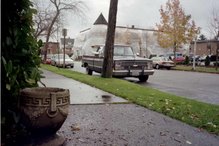
The piano accompanist for choir concerts by the Runeberg Choir in 1930 was Linnea Gord, my mother (Linnea Gord Jensen). She saved lots of things, including ribbons (pctured). She wrote about June 21, 1930 in Jacobstad, "The concert was held at Bradkorshuset. The hall was packed, but it was a small hall. We received a wreath, with pink carnations. It sure was beautiful."
The poet Johan Ludwig Runeberg, born 1804 in Osterbotten, a Swedish-speaking national poet of
This hymn is performed at some concerts by the Runeberg Choirs in different years.
Himlars Rymd Sin Konung Ärar
Himlars Rymd sin konung ärar
Himlars härar prisa den dem väsen gett.
Fästet skaparns namn förkunnar, stjärne munnar
sjonga utan
Dagen spegla vill för dagen
Anletsdragen av den sok som evig är.
Natt, som var, åt natt, som bliver, Budskap Giver,
att den högsta spiran bär.
Hvar ett språk förnims och höres
Tunga röres, hvar ett ord
Hvar en suck, ett ljud
allt om Herren vittne här.
All ting skapedt lyder herran,
När och fjärran, i hans vilja röres allt,
Skåda dagens konungs bana
Se och spana, går han ej, som Gud befallt?
Som en brudgrum fram han träder,
Ler och gläder, tröttner och till hvila går
Nästa dag han syns med samma
Väg och flamma som för tusen, tusen år.
Vill du lifvets visdom finna,
Vill du vinna, för ditt hjärta frid och tröst,
Lyft mot herran i det höga upp
ditt öga, se hans verk och hör hans röst.
Herrans lagar rubba icki,
Hvart bi blicke, se vi, hur de fasta stå.
Herrans vittnesbörd och lika,
Herrans bud de äro klara,
Uppenbara och upp lysa ögonen.
Herrans fruktan hjärtan renar,
Ädelstenar smycka mänskan ej som den.
Herre, se dock oss, de svaga
Justar jaga, syden för oss på sin stråt.
Ho förstår, hur tidt han bryter,
Håg förbyter? Fräls oss, Herre, och förlåt.
Ära vare Gud I Hojden
Friden, Fröjden, Saligheten vare hans.
Han skall oket sönderkrossa,
God Rules All The Stars And Planets
God rules all the stars and planets.
Heaven's praises ring out of the starry sky.
Since the fimament spoke God's name
The star's voices sing and do not hesitate.
In its mirror the day wishes
The sun's image which is an eternal face.
Night which was to night which will be
Brings a message in the highest, tallest place.
Where a language, heard, shapes being
Where a tongue moves to be speech from just a word.
Where a sigh, a sound car rise, or -
Stammer bow down - all bears witness about God.
All created things obey God.
Near and far off God's will animates it all.
See today the path the king walks -
See it clearly, does it not go as God wills?
God moves like a happy wedding,
Glad, proud, all day and then weary and to rest.
God repeats this every morning -
Waves and brights flames for a thousand happy years.
If you want life's finest wisdom,
Wish your heart healed of its wrong and be at peace
Look to God up in the highest,
Lift your eyes up - hear the song and see the work.
What God mends will not be shaken.
All we glance at, we see it securely is.
Testimonies and God's wittness
Can't deceive us. Those who trust in that are wise.
Messages from God up lift us,
Clearly teach us and illuminate the eye.
That we fear God makes our hearts clean.
Wealthy jewels cannot decorate that way.
God, look down upon us weak ones,
Hunt for justice and correct us on your path.
Who can know how times breaks open,
Providential? God forgive us, God please save.
God is in the heights of heaven.
Perfect peace, joy, and eternal bliss are there.
God shall tear all chains asunder
For us lost ones, we will not sin anymore.
Introducing Live Search cashback . It's search that pays you back! Try it Now


